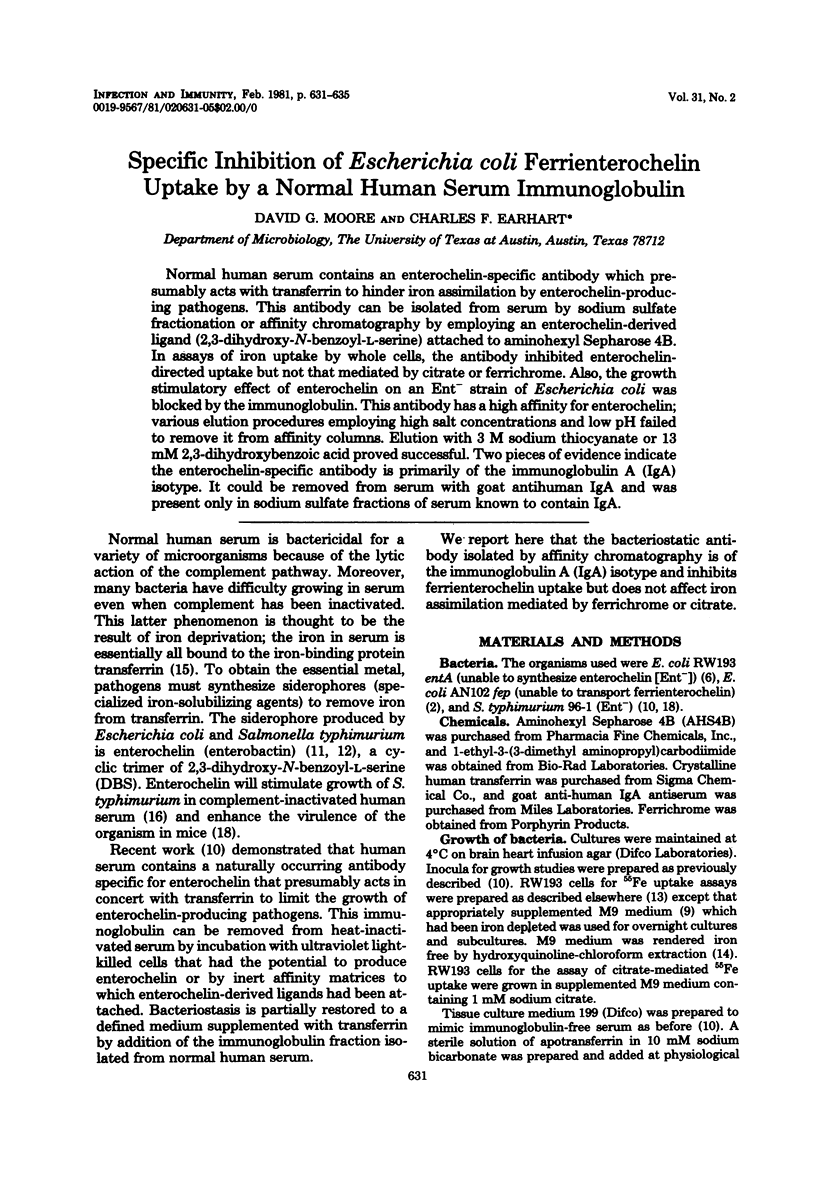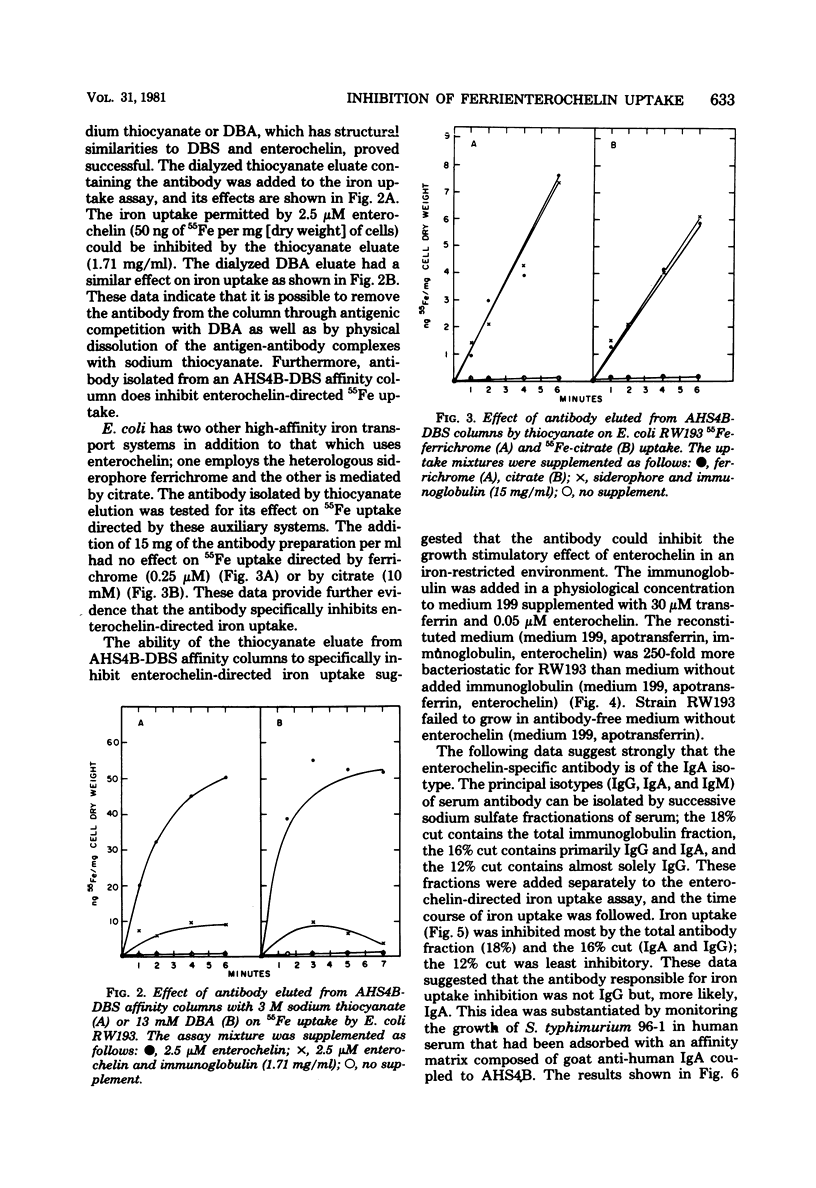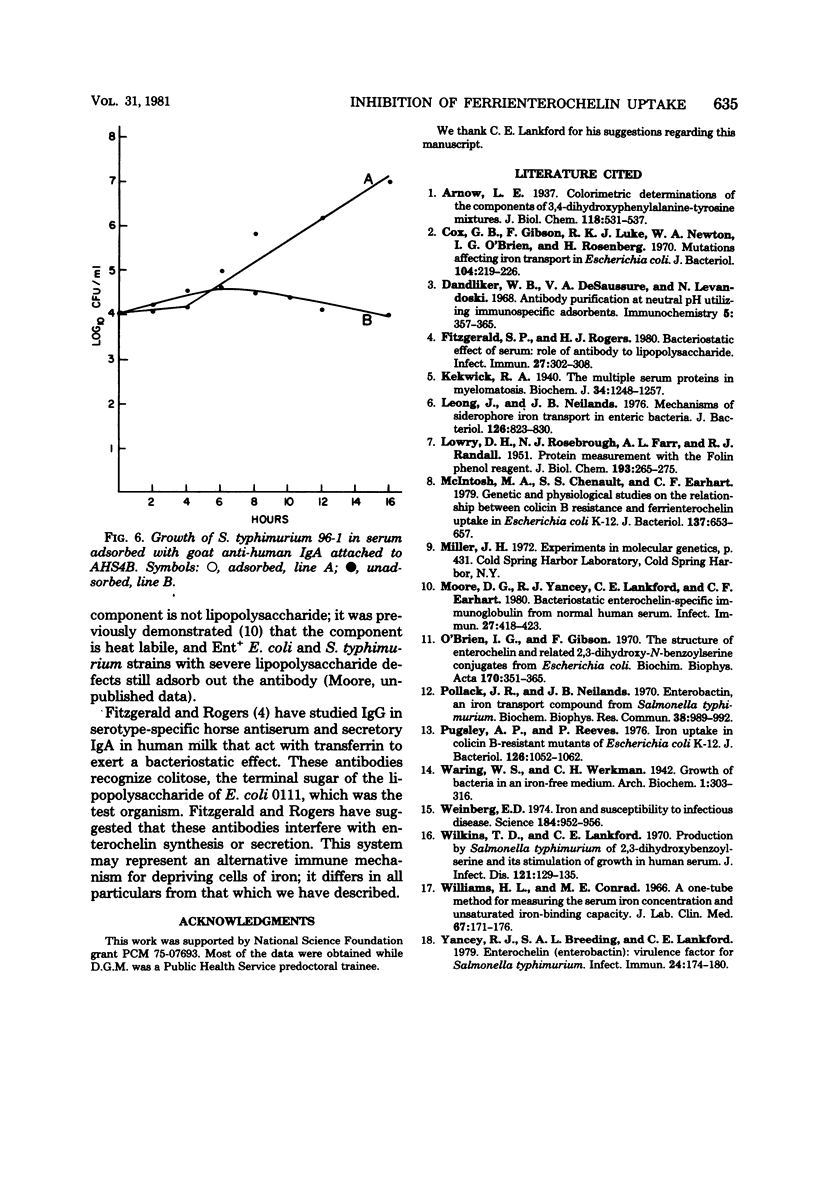Abstract
Normal human serum contains an enterochelin-specific antibody which presumably acts with transferrin to hinder iron assimilation by enterochelin-producing pathogens. This antibody can be isolated from serum by sodium sulfate fractionation or affinity chromatography by employing an enterochelin-derived ligand (2,3-dihydroxy-N-benzoyl-L-serine) attached to aminohexyl Sepharose 4B. In assays of iron uptake by whole cells, the antibody inhibited enterochelin-directed uptake but not that mediated by citrate or ferrichrome. Also, the growth stimulatory effect of enterochelin on an Ent- strain of Escherichia coli was blocked by the immunoglobulin. This antibody has a high affinity for enterochelin; various elution procedures employing high salt concentrations and low pH failed to remove it from affinity columns. Elution with 3 M sodium thiocyanate or 13 mM 2,3-dihydroxybenzoic acid proved successful. Two pieces of evidence indicate the enterochelin-specific antibody is primarily of the immunoglobulin A (IgA) isotype. It could be removed from serum with goat antihuman IgA and was present only in sodium sulfate fractions of serum known to contain IgA.
Full text
PDF




Selected References
These references are in PubMed. This may not be the complete list of references from this article.
- Cox G. B., Gibson F., Luke R. K., Newton N. A., O'Brien I. G., Rosenberg H. Mutations affecting iron transport in Escherichia coli. J Bacteriol. 1970 Oct;104(1):219–226. doi: 10.1128/jb.104.1.219-226.1970. [DOI] [PMC free article] [PubMed] [Google Scholar]
- Dandliker W. B., De Saussure V. A. Antibody purification at neutral pH utilizing immunospecific adsorbents. Immunochemistry. 1968 Jul;5(4):357–365. doi: 10.1016/0019-2791(68)90131-6. [DOI] [PubMed] [Google Scholar]
- Fitzgerald S. P., Rogers H. J. Bacteriostatic effect of serum: role of antibody to lipopolysaccharide. Infect Immun. 1980 Feb;27(2):302–308. doi: 10.1128/iai.27.2.302-308.1980. [DOI] [PMC free article] [PubMed] [Google Scholar]
- Kekwick R. A. The serum proteins in multiple myelomatosis. Biochem J. 1940 Sep;34(8-9):1248–1257. doi: 10.1042/bj0341248. [DOI] [PMC free article] [PubMed] [Google Scholar]
- LOWRY O. H., ROSEBROUGH N. J., FARR A. L., RANDALL R. J. Protein measurement with the Folin phenol reagent. J Biol Chem. 1951 Nov;193(1):265–275. [PubMed] [Google Scholar]
- Leong J., Neilands J. B. Mechanisms of siderophore iron transport in enteric bacteria. J Bacteriol. 1976 May;126(2):823–830. doi: 10.1128/jb.126.2.823-830.1976. [DOI] [PMC free article] [PubMed] [Google Scholar]
- McIntosh M. A., Chenault S. S., Earhart C. F. Genetic and physiological studies on the relationship between colicin B resistance and ferrienterochelin uptake in Escherichia coli K-12. J Bacteriol. 1979 Jan;137(1):653–657. doi: 10.1128/jb.137.1.653-657.1979. [DOI] [PMC free article] [PubMed] [Google Scholar]
- Moore D. G., Yancey R. J., Lankford C. E., Earhart C. F. Bacteriostatic enterochelin-specific immunoglobulin from normal human serum. Infect Immun. 1980 Feb;27(2):418–423. doi: 10.1128/iai.27.2.418-423.1980. [DOI] [PMC free article] [PubMed] [Google Scholar]
- Pollack J. R., Neilands J. B. Enterobactin, an iron transport compound from Salmonella typhimurium. Biochem Biophys Res Commun. 1970 Mar 12;38(5):989–992. doi: 10.1016/0006-291x(70)90819-3. [DOI] [PubMed] [Google Scholar]
- Pugsley A. P., Reeves P. Iron uptake in colicin B-resistant mutants of Escherichia coli K-12. J Bacteriol. 1976 Jun;126(3):1052–1062. doi: 10.1128/jb.126.3.1052-1062.1976. [DOI] [PMC free article] [PubMed] [Google Scholar]
- Weinberg E. D. Iron and susceptibility to infectious disease. Science. 1974 May 31;184(4140):952–956. doi: 10.1126/science.184.4140.952. [DOI] [PubMed] [Google Scholar]
- Wilkins T. D., Lankford C. E. Production by Salmonella typhimurium of 2,3-dihydroxybenzoylserine, and its stimulation of growth in human serum. J Infect Dis. 1970 Feb;121(2):129–136. doi: 10.1093/infdis/121.2.129. [DOI] [PubMed] [Google Scholar]
- Williams H. L., Conrad M. E. A one-tube method for measuring the serum iron concentration and unsaturated iron-binding capacity. J Lab Clin Med. 1966 Jan;67(1):171–176. [PubMed] [Google Scholar]
- Yancey R. J., Breeding S. A., Lankford C. E. Enterochelin (enterobactin): virulence factor for Salmonella typhimurium. Infect Immun. 1979 Apr;24(1):174–180. doi: 10.1128/iai.24.1.174-180.1979. [DOI] [PMC free article] [PubMed] [Google Scholar]


